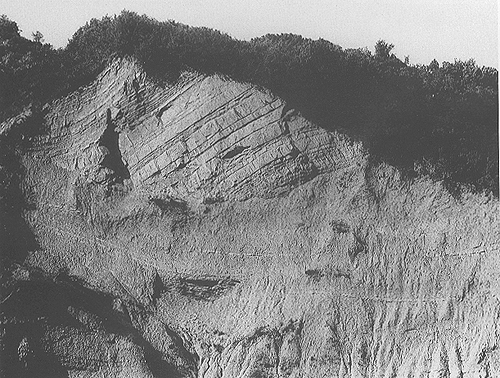
Rotated block in a paleoslide
Plate 134

Rotated block in a paleoslide
Plate 134
The displaced character of this sandstone bedset is made obvious by its truncation and discordant dip with respect to underlying bedding. Moreover, its base is curve and cuts across the beds. A level of unbedded, dark mudstone separates the sandstone body from the substratum, made of mudstones with interbedded thin sandstones. The sandstone bedset is not deformed inside and clearly behaved as a rigid block during sliding. It also rotated and assumed an upslope dip, more or less like a person who lets his back slide on an armchair when taking a nap or watching TV.
Slided blocks are also named olistoliths, from a combination of two Greek words meaning "sliding stones". They can be found both as components (sort of giant particles or clasts) of slide and debris flow bodies or as isolated occurrences, not embedded in any "matrix". In the latter case, the blocks can either represent forerunners of a major slid mass or dispersed remnants of a completely fragmented body.
Marnoso-arenacea Formation, Santerno Valley, northern Apennines
A term often employed for a body made of chaotic and/or brecciated mudstones embedding rigid blocks is olistostrome (literally, "slided body"). The olistostrome concept was proposed by an Italian oil geologist (Flores) in the late fifties but not adequately defined. Neither the mode nor the speed of sliding was specified, or whether it should be regarded as a sedimentary or a tectonic process. Olistostrome has thus been used for tectonic me;aalanges and tectonic (friction) breccias on one side, for debris flow deposits on the other.